
A revelatory Donna Mills lights up the Colony Theatre stage as the title character in Driving Miss Daisy, Alfred Uhry’s Pulitzer Prize-winning look back in time at an aging Southern Jewish widow and the African-American driver foisted upon her by her adult son in the years just preceding the Civil Rights Movement.
The place is Atlanta, Georgia, the year is 1948, and 72-year-old Daisy Werthan, who’s been driving herself around town for the past half-century, has just backed her car into a neighbor’s garage.
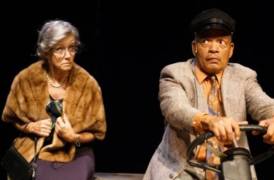 Enter Hoke Coleburn (Arthur Richardson), an unschooled African-American driver/delivery man a dozen years Miss Daisy’s junior, hired by her 40ish son Boolie (James Leo Ryan) to do precisely what Uhry’s play’s title suggests, and if Miss Daisy ends up agreeing to the bargain, it’s not without protest. After all, if a lady needs a driver to get her around Atlanta when she’s barely past seventy, what does that say about what lies ahead?
Enter Hoke Coleburn (Arthur Richardson), an unschooled African-American driver/delivery man a dozen years Miss Daisy’s junior, hired by her 40ish son Boolie (James Leo Ryan) to do precisely what Uhry’s play’s title suggests, and if Miss Daisy ends up agreeing to the bargain, it’s not without protest. After all, if a lady needs a driver to get her around Atlanta when she’s barely past seventy, what does that say about what lies ahead?
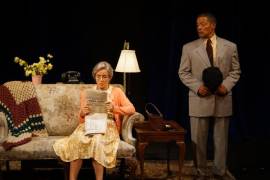 Uhry’s 1987 off-Broadway smash unfolds over twenty-five years in a series of vignettes that take us from Miss Daisy’s initial insistence upon taking the trolley to the Piggly Wiggly to her certainty that Hoke has filched a can of salmon from her pantry to a series of events provoked by Southern resistance to Civil Rights, all of this leading towards a relationship between two people who under normal circumstances would likely never have met, let alone bonded over time.
Uhry’s 1987 off-Broadway smash unfolds over twenty-five years in a series of vignettes that take us from Miss Daisy’s initial insistence upon taking the trolley to the Piggly Wiggly to her certainty that Hoke has filched a can of salmon from her pantry to a series of events provoked by Southern resistance to Civil Rights, all of this leading towards a relationship between two people who under normal circumstances would likely never have met, let alone bonded over time.
Under Heather Provost’s assured direction, performances could hardly be finer.
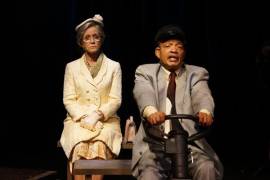 Making a complete one-eighty from glamorous Knots Landing vixen Abby Fairgate, leading lady Mills vanishes into cranky old Miss Daisy without losing an iota of her beauty and charm in a performance of humor, pathos, and depth that impresses, moves, and delights.
Making a complete one-eighty from glamorous Knots Landing vixen Abby Fairgate, leading lady Mills vanishes into cranky old Miss Daisy without losing an iota of her beauty and charm in a performance of humor, pathos, and depth that impresses, moves, and delights.
Richardson’s Hoke gives Mills’ Miss Daisy as good as he gets, bringing to life a man of insight, intelligence, and wit who may have spent little time in school but has learned much about life, people, and self-worth along the way.
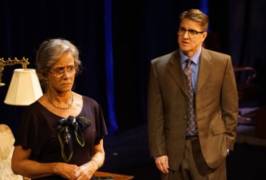 Last but not least, Ryan does some of his finest work as Miss Daisy’s long-suffering but devoted son, and like his two costars ages subtly but believably over the course of twenty-five years.
Last but not least, Ryan does some of his finest work as Miss Daisy’s long-suffering but devoted son, and like his two costars ages subtly but believably over the course of twenty-five years.
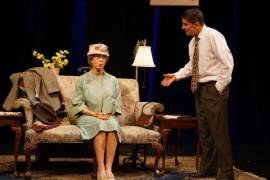 Scenic designer Genetra Tull effectively divides the Colony stage into three playing areas, though its curtained backdrop gives the production a less professional look than it deserves, particularly compared to Jean Lomastro’s period-perfect costumes, John McElveney’s equally era-appropriate properties, and Donny Jackson’s first-rate lighting design. (Jackson’s driving effects are particularly impressive.)
Scenic designer Genetra Tull effectively divides the Colony stage into three playing areas, though its curtained backdrop gives the production a less professional look than it deserves, particularly compared to Jean Lomastro’s period-perfect costumes, John McElveney’s equally era-appropriate properties, and Donny Jackson’s first-rate lighting design. (Jackson’s driving effects are particularly impressive.)
Jessica Mills has designed a single character-establishing wig for Miss Daisy, though a second for her octogenarian years would help reinforce the character’s increasing decrepitude.
Mike Napoli’s sound design underscores each of Driving Miss Daisy’s several dozen scene changes with a different, decade-appropriate bit of Hit Parade/Top 40 pop and would be even better if it featured more effects. (Daisy’s car never seems makes a noise, for example, and the play’s occasional outdoor scenes could benefit from ambient sounds.) Also, an intermission seems a unnecessary break in what would play better as an uninterrupted 85-minute one-act.
Elena Cruz is stage manager. Noelle Berry is assistant director.
It’s been two years since the Colony Theatre ceased operations after four decades of producing some of L.A.’s finest live theater. Driving Miss Daisy is a reminder of how much this Burbank gem is missed, and with Donna Mills at her most luminous, there is reason to both cheer its return and make a holiday wish for more Colony magic in the New Year.
Colony Theatre, 555 North Third Street, Burbank.
www.colonytheatre.org
–Steven Stanley
November 24, 2017
Photos: Justin Wilcox
Tags: Alfred Uhry, Colony Theatre, Donna Mills, Los Angeles Theater Review



 Since 2007, Steven Stanley's StageSceneLA.com has spotlighted the best in Southern California theater via reviews, interviews, and its annual StageSceneLA Scenies.
Since 2007, Steven Stanley's StageSceneLA.com has spotlighted the best in Southern California theater via reviews, interviews, and its annual StageSceneLA Scenies.







 COPYRIGHT 2025 STEVEN STANLEY :: DESIGN BY
COPYRIGHT 2025 STEVEN STANLEY :: DESIGN BY